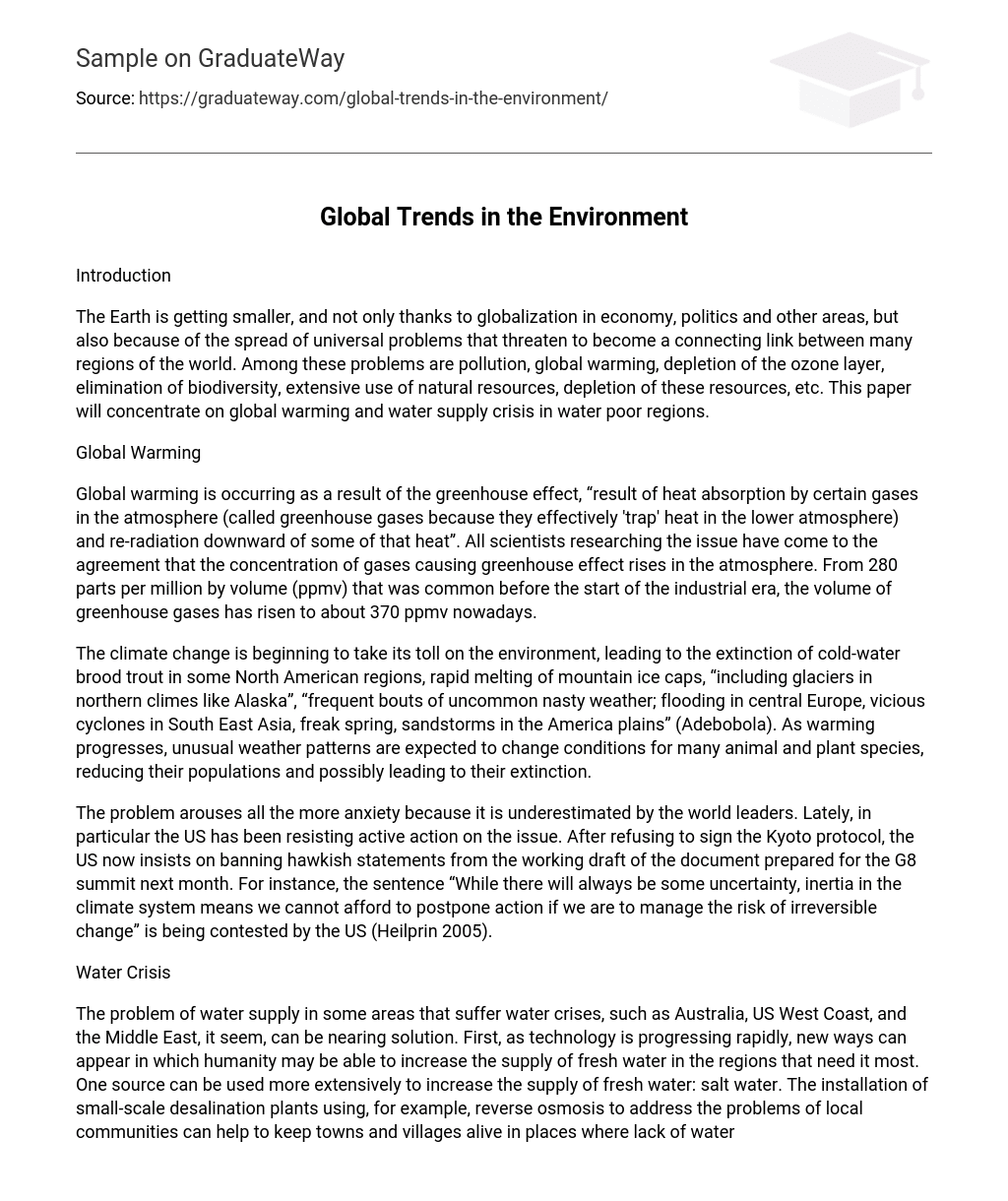Introduction
The Earth is getting smaller, and not only thanks to globalization in economy, politics and other areas, but also because of the spread of universal problems that threaten to become a connecting link between many regions of the world. Among these problems are pollution, global warming, depletion of the ozone layer, elimination of biodiversity, extensive use of natural resources, depletion of these resources, etc. This paper will concentrate on global warming and water supply crisis in water poor regions.
Global Warming
Global warming is occurring as a result of the greenhouse effect, “result of heat absorption by certain gases in the atmosphere (called greenhouse gases because they effectively ‘trap’ heat in the lower atmosphere) and re-radiation downward of some of that heat”. All scientists researching the issue have come to the agreement that the concentration of gases causing greenhouse effect rises in the atmosphere. From 280 parts per million by volume (ppmv) that was common before the start of the industrial era, the volume of greenhouse gases has risen to about 370 ppmv nowadays.
The climate change is beginning to take its toll on the environment, leading to the extinction of cold-water brood trout in some North American regions, rapid melting of mountain ice caps, “including glaciers in northern climes like Alaska”, “frequent bouts of uncommon nasty weather; flooding in central Europe, vicious cyclones in South East Asia, freak spring, sandstorms in the America plains” (Adebobola). As warming progresses, unusual weather patterns are expected to change conditions for many animal and plant species, reducing their populations and possibly leading to their extinction.
The problem arouses all the more anxiety because it is underestimated by the world leaders. Lately, in particular the US has been resisting active action on the issue. After refusing to sign the Kyoto protocol, the US now insists on banning hawkish statements from the working draft of the document prepared for the G8 summit next month. For instance, the sentence “While there will always be some uncertainty, inertia in the climate system means we cannot afford to postpone action if we are to manage the risk of irreversible change” is being contested by the US (Heilprin 2005).
Water Crisis
The problem of water supply in some areas that suffer water crises, such as Australia, US West Coast, and the Middle East, it seem, can be nearing solution. First, as technology is progressing rapidly, new ways can appear in which humanity may be able to increase the supply of fresh water in the regions that need it most. One source can be used more extensively to increase the supply of fresh water: salt water. The installation of small-scale desalination plants using, for example, reverse osmosis to address the problems of local communities can help to keep towns and villages alive in places where lack of water threatens their survival.
Another new way to address the problem was found in the US West Coast known for its water scarcity. Businessmen there had an idea to transport water from the North Coast that is considered to be rich in water. After water flows into bags attached to river estuaries, tug boats will take the giant bags to California from Alaska. Bags will easily float as they will be full of fresh water that is lighter than salt water. Transporting water from one area to another can help to solve the problem, replacing scarcity in one region with excess in another. All of the above, however, needs to be carried out in accordance with the requirements of local communities that want to keep their rivers plentiful.
Conclusion
Some of the world’s problems, like poverty and lack of water supply in some areas can be solved via advances in technology. Others, like global warming and extinction of species are precipitated by it. However, humanity can only hope that harmful trends will be harnessed before they can have an irreversible effect on our planet.
Works Cited
Adebobola, Nathaniel-Imeh. The Environment: Re-Addressing Global Trends and Contemporary Issues. www.ajeam-ragee.org/ getdoc.asp?fpath=c:%5Cdomains%5Cajeam-ragee.org%5Cdb%5Cvol9Oct2004p43t48.doc (June 21, 2005)
DeDanan, Mary. Water Fight. Gualala and Albion River Communities Try to Sink Giant Water Bag Scheme. West by Northwest.org online magazine, August 3, 2002. http://www.westbynorthwest.org/artman/publish/article_22.shtml (June 21, 2005)
Desalination solution to West Coast water crisis. West Coast Centinel, 26 May 2005. http://ceduna.yourguide.com.au/detail.asp?class=news&subclass=local&category=general%20news&story_id=396746&y=2005&m=5 (June 21, 2005)
Heilprin, John. U.S. Resists Strong Summit Language on Global Warming. ENN, June 20, 2005. http://www.enn.com/today.html?id=8008 (June 21, 2005)
National Oceanic and Atmospheric Administration. Global Warming: Frequently Asked Questions. http://www.ncdc.noaa.gov/oa/climate/globalwarming.html (June 21, 2005)





